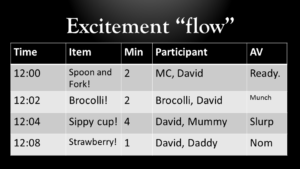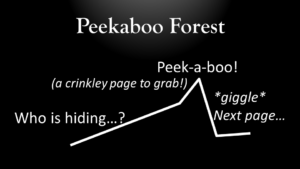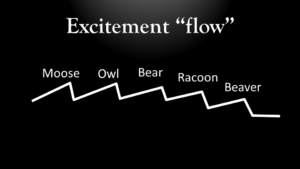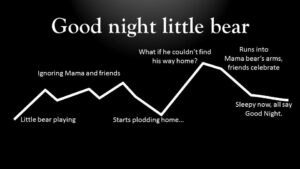Recently I had the opportunity to do a workshop / seminar with the Logos Hope Events team about Theatre & Storytelling. I love theatre, and am very passionate about making (especially Childrens’) events into engaging stories, rather than just variety shows with a 5 minute message tacked on the end.
This is kind of a summary of what I covered, with some of the slides I made. There’s quite a lot of content, so I’m splitting it up into 3 posts.
Storytime!
To start off, we looked at 3 of David’s books, which I brought along.
- Mealtime
- Peekaboo Forest
- Good Night, Little Bear
Mealtime is basically just a list of items you might find at mealtimes:
Spoon and Fork,
Brocolli,
Sippy cup,
Strawberry...
and so on. Not staggeringly inspiring. Often, however, events are organised in a similar manner. Get a list of things we want to put in (Introduction video, Korean fan dance, Refreshments, Sermon, Singing), have an MC or host link them all together (“Wow, that was amazing. Next we have…”) and suddenly you’ve got a programme.
In terms of energy levels of the audience, it looks something like this: Each individual item may be all right, but they’re not really connected, and nothing really keeps the attention. And it doesn’t get more exciting, and … well. I forgot what I was … er, better check facebook.
Each individual item may be all right, but they’re not really connected, and nothing really keeps the attention. And it doesn’t get more exciting, and … well. I forgot what I was … er, better check facebook.
Peekaboo Forest is quite a bit better. Each page asks a question:
‘Who is hiding behind the spruce?’
there’s then a nice crinkly page to turn over:
Peek-a-boo! It’s the Moose!
So each page has quite a nice “energy” flow:
with good anticipation, etc. But in terms of overall story-arc, it’s very dull.
It really doesn’t go anywhere, and often programmes are like that too. Each individual item may be great, but you don’t lead the audience anywhere, and don’t have everything tied together.
Good Night, Little Bear is much more interesting. We read this to David almost every night, and even though it doesn’t have crinkly pages, he still seems to really enjoy it. The story is (essentially) little bear not wanting to go to bed, instead he goes off to play, until eventually he watches the sunset, it gets dark, and he realises he should have listened to Mama bear, and in fact he’s lost now and can’t find his way home. But then Mama bear, assisted by Little Bear’s friends, Mouse and Squirrel, come to find Little Bear. He hears them calling him, and runs to Mama Bear’s arms. He’s now feeling tired, and goes to bed. It’s really well told, with lovely pictures, and so on.
A much more complex rough energy flow chart.
So that’s the “energy flow” concept. Reasonably simple to grasp. If we are making an event which is a variety show / sandwhich programme, or a concert, then it’s worth thinking about this stuff, and saying “How do we want to start? Something big and fun to grab the attention, and then we can settle down a bit, work our way up to a climax, and then slowly bring it to a close…”.
Thinking about the age-group as well is very important. How long are attention spans, what is important or exciting? If there is going to be a verbal message / talk, then at what point will the audience be willing to sit and listen?
If we want to make the event into a story, then we’ll need to go a bit deeper.
For that, we’ll have to wait until Part 2…





2 replies on “Story Telling (Part 1) – Energy”
[…] Story Telling (Part 1) – Energy […]
[…] Story Telling (Part 1) – Energy […]